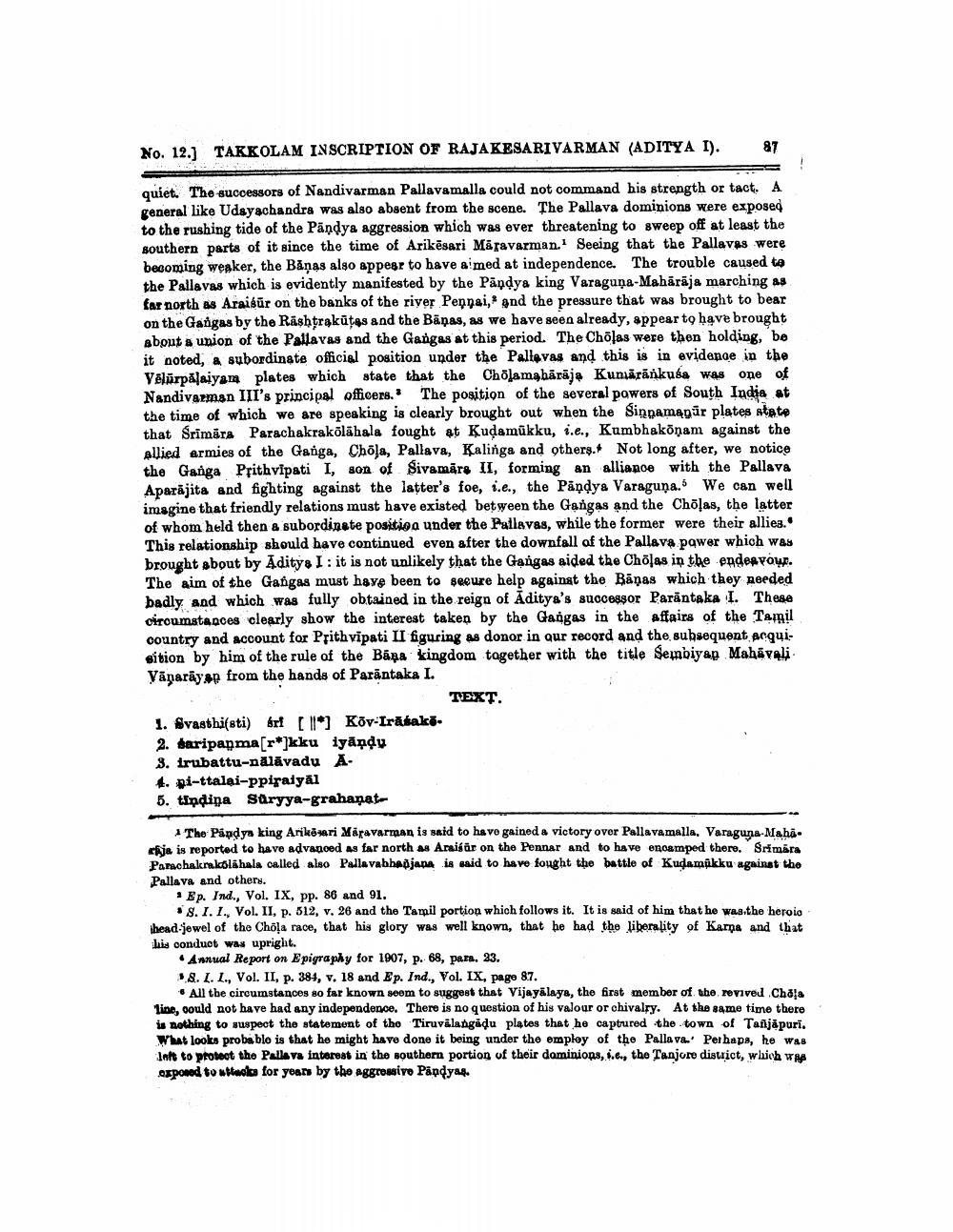________________
No. 12.) TAKKOLAM INSCRIPTION OF RAJAKESARIVARMAN (ADITYA I).
87
quiet. The successors of Nandivarman Pallavamalla could not command his strength or tact. A. general like Udayachandra was also absent from the scene. The Pallava dominions were exposed to the rushing tide of the Pandya aggression which was ever threatening to sweep off at least the southern parts of it since the time of Arikēsari Märavarman." Seeing that the Pallaves were becoming weaker, the Bånas also appear to have aimed at independence. The trouble caused to the Pallaves which is evidently manifested by the Pandya king Varaguņa-Mahārāja marching as far north as Araisūr on the banks of the river Peņņai, and the pressure that was brought to bear on the Gangas by the Rashtrakūtas and the Bāņas, as we have seen already, appear to have brought about a union of the Pallavas and the Gangas at this period. The Cholas were then holding, be it noted, a subordinate official position under the Pallavas and this is in evidence in the Vēlārpālaiyan plates which state that the Cholamahārāją Kunārānkusa was one of Nandivarman III's principal officers. The position of the several powers of South India at the time of which we are speaking is clearly brought out when the Singamagar plates state that Srimära Parachakrakālāhala fought at Kudamūkku, i.e., Kumbhakonam against the allied armies of the Ganga, Chola, Pallava, Kalinga and others. Not long after, we notice the Ganga Prithvipati I, son of Sivamāre II, forming an alliance with the Pallava Aparajita and fighting against the latter's foe, i.e., the Pandya Varaguna. We can well imagine that friendly relations must have existed between the Gangas and the Chõļas, the latter of whom held then & subordinate position under the Pallavas, while the former were their allies. This relationship should have continued even after the downfall of the Pallava power which was brought about by Aditys I: it is not unlikely that the Gangas aided the Cholas in the endeavou. The aim of the Gangas must have been to secure help against the Banas which they needed badly and which was fully obtained in the reign of Aditya's successor Parāntaka I. These circumstances clearly show the interest taken by the Gangas in the affairs of the Tamil country and account for Prithvipati II figuring as donor in qur record and the subsequent acqui sítion by him of the rule of the Bapa kingdom together with the title Sembiyap Mahávali Vāparāyap from the hands of Parantaka I.
TEXT. 1. Avasthissti) krt [11] Kõv-Irākako. 2. daripapma[r*]kku iyāņdy 3. trubattu-nälāvadu A. 4. pi-ttalai-ppiraiyal 5. tindiņa Suryya-grahaņat
The Pipdya king Arikori Maravarman is said to have gained a victory over Pallavamalla, Varaguna Mahaja is reported to have advanced as far north as Araisär on the Pennar and to have enoamped there. Srimara Panchakrkoláhala called also Pallavabhadjana is said to have fought the battle of Kudamökku against the Pallava and others.
1 Ep. Ind., Vol. IX, pp. 86 and 91.
S.I.I., Vol. II, p. 512, v. 26 and the Tamil portion which follows it. It is said of him that he was the herois head-jewel of the Chöļa race, that his glory was well known, that he had the liberality of Karna and that his conduct was upright.
• Annual Report on Epigraphy for 1907, p. 68, par. 23.
8. L. I., Vol. II, p. 384, v. 18 and Ep. Ind., Vol. IX, page 87.
• All the circumstances so far known seem to suggest that Vijayalaya, the first member of the revived Choa line, could not have had any independence. There is no question of his valour or chivalry. At the same time there is nothing to suspect the statement of the Tiruvalangadu plates that he captured the town of Tafijapuri. What looks probable is that he might have done it being under the employ of the Pallava.' Perhaps, he was Antt to protect the Pallava interest in the southern portion of their dominions, 6.6., the Tanjore district, which was exponed to studio for years by the aggressivo Pandya4.




